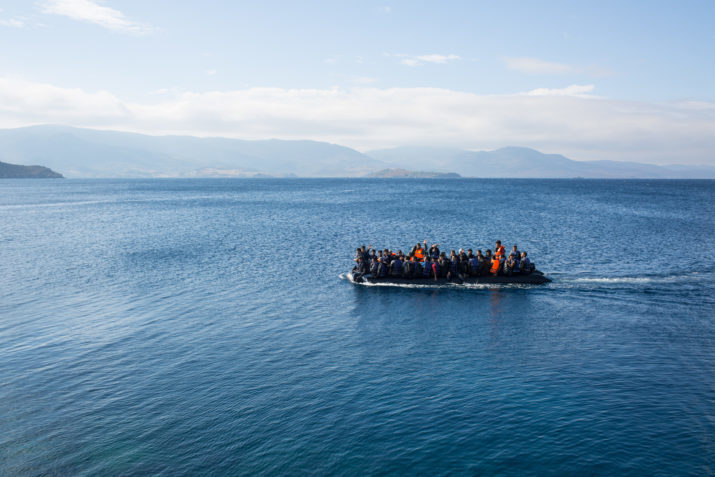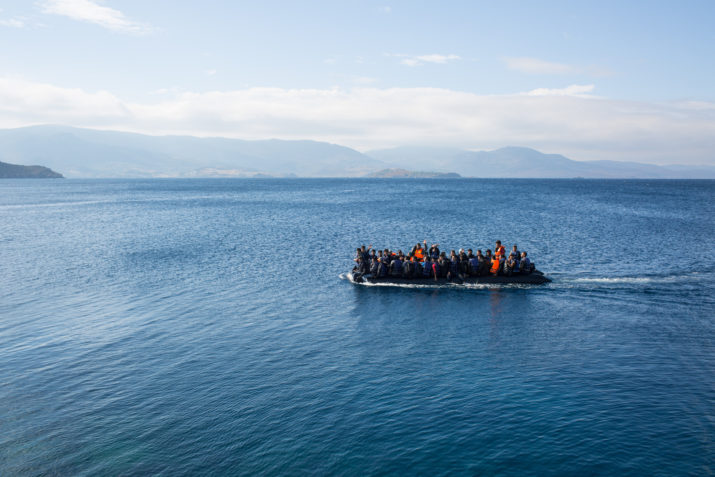

This is part of our special feature Governing the Migration Crisis.
The sea offers hope but also dread for boat refugees leaving behind one region and setting sail for another. As well as being a connector, water acts as an obstacle for boat refugees to overcome. It is an ambiguous and liminal space that can lead to new beginnings but also terrible endings, as highlighted by the death of over 10,000 people in search of asylum on the Mediterranean in the 2010s. The recent refugee crisis is not the first time that people have fled war, persecution, human rights abuses, and economic chaos in the post-war era by taking to the high seas. Tens of thousands of refugees attempted to sail across the Mediterranean in the 1940s, hundreds of thousands traversed the South China Sea in the 1970s and 1980s, and the Caribbean in the 1980s and 1990s. Europe too has also had to deal with sizeable numbers of migrants arriving irregularly by boat in search of asylum since the early 1990s. Yet, commentators discussing what occurred more recently have rarely made reference to the reaction of other regions and states around the world to the arrival of boat refugees in the past. This is a real pity because comparing the response of regions and states to boat refugees across time and space highlights the uniqueness of what occurred when over one million boat refugees crossed the Mediterranean in the 2010s.
Until more recently, boat refugees were usually met with a hostile reception. Britain in the 1940s, the United States in the 1990s, and Australia in the 2000s placed boat refugees into prison camps outside their territory. Malaysia, which received the most Vietnamese boat refugees in the South East Asian region in the late 1970s, successfully forced tens of thousands of refugees out of its territorial waters back onto the perilous high seas. The United States interdicted and returned Haitians in the 1980s on the high seas. Italy detained thousands of Albanian boat migrants in search of asylum in a football stadium for several days in August 1991 before repatriating them against their will. Italy also pushed boat migrants back towards Libya in 2009. Yet in the 2010s, Europe generally welcomed migrants who sailed irregularly from Turkey to Greece in search of asylum and the Italian Coastguard, and other EU states, even went out of their way to rescue tens of thousands of boat refugees in Libyan and international waters before transporting them to Italy. This article aims to provide a short overview of how states and regions have reacted to boat refugees around the world since the 1940s. In doing so, it will also try to explain why Europe reacted so differently to boat refugees in 2010s than the historical cases cited.
What the boat refugees in each of these cases share in common is that they mostly escaped persecution or some kind of political or humanitarian crisis. They generally sailed to states that were politically and economically more stable than those from which they fled. They used boats because it was often the only way to access states that were otherwise closed off to them because of migration restrictions. The media covered the arrival of boat refugees in much greater depth than other migrants and refugees travelling by plane, train, car, bus, and regular shipping lines. This attention provoked public and political debates that touched on illegality, security, and sovereignty on the one hand, but also morality, compassion, and humanitarianism on the other. As a result of this, and the fact that the journey boat refugees made was fraught with real danger, the issue of boat refugees garnered attention in public discourse disproportionate to its size.
The label “boat migrants” may technically be more accurate to account for these people, but it does not adequately capture the fact that so many of them fled conflicts and significant political instability in their home countries unlike “migrants” more generally – hence my use of the term ‘“boat refugees.” The term “boat people” is associated mainly with those fleeing Vietnam in the 1970s, which explains why I do not use this term. Of course, refugees took to the high seas much earlier than the 1940s but they did not face the same kind of immigration regimes that developed in the inter-war years. I make a distinction between refugees who sailed with valid papers for entry to their country of destination aboard official shipping lines and those who travelled irregularly. For example, I do not consider the over 900 people aboard the infamous SS St. Louis in 1939 as boat refugees because the Hamburg-Amerika line legally organized their voyage to Havana and the passengers had received Cuban landing certificates and transit visas before departing. The tens of thousands of Jewish refugees who tried to reach Palestine in the 1940s, by contrast, sailed in unregulated vessels organized by smugglers and possessed no legal documents enabling them to land.
Due to Arab unrest at British rule and increasing Jewish immigration in the late 1930s, the British imposed strict immigration quotas for Mandatory Palestine. To deter unregulated immigration, the British placed Jewish refugees trying to reach the territory by boat into a prison camp in Atlit in Palestine during the Second World War. They also experimented with placing Jewish boat refugees in detention camps on Mauritius when they sent over 1,500 to the island in late 1940 and kept them there until 1945.[1] After the war, the British transferred over 50,000 Jewish boat refugees to twelve different prison camps in Cyprus.[2] The newly established Israeli state brought the remaining internees from Cyprus to Israel in 1948 and early 1949.
Perhaps the most famous historic episode involving boat refugees took place in the South China Sea in the 1970s. South East Asian states placed Vietnamese “boat people” who arrived in the late 1970s into cramped refugee camps and waited for North American, Australasian, and West European states to resettle them. As the numbers of boat people arriving grew rapidly in 1979 and the rate of resettlement slowed, states in the region began to adopt a much harder line. The Malaysian vice prime minister, for example, stated in June 1979 that his country would shoot boat people on sight if numbers did not decrease.[3] Neighboring countries also voiced their intention to stop boat people from entering their territory. To deter such action, the UNHCR, at the behest of the British, whose colony of Hong Kong also received large numbers of Vietnamese refugees, convened an international conference in Geneva where mostly western states promised to expedite and increase resettlement (unlike the European Commission’s 2015 plan to resettle 160,000 refugees throughout the EU – only approximately 25,000 had moved by July 2017 – states did as they promised). To deter people from leaving Vietnam in such a disorganized and dangerous manner, the UNHCR formed an agreement with the Vietnamese government to establish a system that would allow people to leave in a more orderly fashion.
Just as the 1979 international conference dedicated to the Indochinese refugee crisis began to alleviate some of the problems encountered by host South East Asian states, boat refugees in the Caribbean started to gain more prominence. Boat refugees from Cuba and Haiti had arrived in the United States throughout the 1970s but the scale of arrival remained relatively low until 1980. The American response to the different movements in the 1980s and 1990s demonstrated the political nature of the reaction of some states to boat refugees during and after the Cold War. Whereas the United States resettled hundreds of thousands of Vietnamese boat refugees in the 1970s and 1980s and allowed 125,000 Cubans to enter Miami in the 1980 Mariel boatlift, Haitians received a much more hostile reception because the Haitian dictator, in contrast to the Cuban one, remained an American ally. From 1981 onward, the US instigated a policy to intercept and return Haitians on the high seas. After the overthrow of a democratically elected president (Jean Bertrand Aristide) in Haiti in 1991, the American Coast Guard began to interdict Haitians at sea and instead of returning them to Haiti, brought them to Guantanamo to process their applications for asylum. After the demise of the Soviet Union, the US Coast Guard also started to intercept Cubans at sea and detain them alongside Haitians at Guantanamo before repatriating them.
Throughout the 1990s, Australia became host to a growing number of boat refugees. Authorities placed the first Cambodians and Chinese in increasingly isolated detention centers to deter future arrivals, but by the late 1990s, significant amounts of boat refugees began to arrive from Iraq, Iran, and Afghanistan. In response to growing public opposition to their arrival, the government of the day introduced its “Pacific Solution” in 2001, which involved transferring boat refugees found on route for Australia to two small Pacific islands: the Republic of Nauru and Papua New Guinea’s Manus Island in a move that bore some resemblance to the American use of Guantanamo.[4] The disappearance of boat refugees from Australian shores after 2001 caused a new government to suspend the policy in 2008. When boat refugees began to arrive once again in sizeable numbers in the 2010s, Australia introduced an updated and even harsher version of its Pacific Solution in 2013 that enabled it to intercept boat refugees and return them on the high seas to Indonesia or transport them to detention centres in Papua New Guinea or Nauru.
Europe also received boat refugees. In the 1990s and 2000s, European states generally reacted to boat migrants in search of asylum in a similar way to other states and regions mentioned above. The Italian police and army placed approximately 15,000 Albanian boat refugees inside a stadium in the southern Italian city of Bari for several days before transporting them back across the Adriatic without allowing them to apply for asylum. Italy then took the precaution of placing its armed forces in Albanian waters – with the acquiescence of the Albanian government. Albanians began to leave by boat for Italy once again in 1997 but as part of Italy’s military intervention in Albania to stem its political crisis, the Italian navy policed the country’s coastline to ensure that boat refugees could not escape. Frustrated at the arrival of growing numbers of boat refugees departing from North Africa and Turkey in the 2000s, Italy instigated agreements bilateral agreements with Turkey, Tunisia, Egypt, and Libya to enable it to repatriate migrants come from countries deemed safe. In 2009, Italy started to push boats found on the high seas back to Libyan waters.
Other southern European countries also began to receive increasing numbers of boat refugees. In 2006, approximately 30,000 boat refugees landed on the Canaries. Spain reacted by signing secretive patrolling and readmission agreements with Mauritania, Cape Verde, and Senegal. Significantly, it also sought EU support from Frontex, an agency set up in 2004 to manage cooperation at the EU’s external borders. Frontex established Operation Hera, which involved both EU members and West African countries. Thereafter, the amount of boat refugees arriving dropped dramatically. Ruben Andersson notes that the key to the operation’s success was that it provided incentives to local forces, which enabled the EU to outbid the people smugglers.[5]
Until 2009, European states appeared to react to the arrival of boat refugees just like others had done around the world since the 1940s: they regularly intercepted and returned them. Yet this all appeared to change in 2013 when Italy launched its Mare Nostrum policy – a military and humanitarian operation involving frigates, patrol boats, helicopters, drones, and radars deployed to help rescue boat migrants found in difficulty in international and territorial waters and bring them to Italy. Despite the cessation of the operation in October 2014 because of the financial burden associated with it, Italy continued to welcome boat migrants rescued at sea to their territory until recently. Over half a million boat refugees arrived in Italy from 2014 to 2016. This represented a remarkable turnaround from Italy’s earlier policies.
In 2015, attention turned from Italy to Greece, where over 800,000 boat refugees landed. Germany announced via twitter in August 2015 that “We are at present largely no longer enforcing #Dublin procedures for Syrian citizens.” This meant that Syrians fleeing their country’s violent civil war did not have to apply for asylum in the first EU country they arrived in, paving the way for massive numbers of migrants in search of asylum to arrive in Greece en route to Germany and other mostly northern EU destinations. This avenue closed in early 2016 when the EU signed a bilateral agreement with Turkey, with the latter agreeing to stop boats disembarking from its territory and receive those found at sea.
Despite the establishment of an agreement with Turkey and Italy’s recent success in reducing the number of boat refugees embarking from Libya, Europe’s reaction to boat refugees in the 2010s represents a remarkable moment in time compared to the response of most states and regions since the 1940s. What explains Europe’s uniqueness? One significant factor is that European states faced more international safeguards than other regions. The role of the European Court of Human Rights (ECtHR) and its 2012 Hirsi Jamaa decision clearly illustrated this when it ruled that Italy had contravened the European Convention on Human Rights and by extension the non-refoulement principle contained in the UN Refugee Convention by pushing twenty-four migrants from the Horn of Africa sailing towards Italy back to Libya in May 2009 without allowing them to apply for asylum.[6] The ECtHR asserted that because the rescue operations on the high seas involved Italian armed forces and Italian crews, Italian and European law applied.
South East Asian states had not signed up the 1951 Refugee Convention and its 1967 Protocol or incorporated them into their national law, meaning that they did not have to abide by certain international norms. American and Australian judges consistently ruled that boat refugees intercepted on the high seas in the Caribbean and Indian Ocean could not access US or Australian law because their interdiction took place on the high seas. In 1985, for example, a US District Court rejected the assertion that the US Coastguard had deprived Haitian boat refugees of the rights afforded them by the US Refugee Act, which invoked the UN Refugee Convention, because they had taken place on the high seas and not on American territory. The US Supreme Court, with Sale v. Haitian Centers Council in 1993, confirmed that US law did not apply outside of its territorial waters. Boat refugees placed by Australia in camps in Nauru challenged their placement in detention through the Australian courts but the High Court ruled that Australian law did not apply: only the law of the countries in which the boat refugees were detained. The US and Australia used the sea as a policy venue to circumvent national and international constraints.[7] European states in the 2010s did not have the same flexibility.
Of course, there are other factors at play. In early October 2013, over 350 boat refugees mostly from Eritrea drowned on their way from Libya to Lampedusa, which provoked an international appeal for action from the UN, the Council of Europe and Pope Francis to help those at sea. It is no coincidence that Italy’s Mare Nostrum policy began shortly thereafter. Yet, Italy had few options, especially since the technocratic government in power in 2012 stated that it would rethink its policies as a result of the ECtHR’s Hirsi Jamaa judgement. Furthermore, the Italian centre-left that came to power in early 2013 had reacted to the ECtHR decision by describing the pushbacks as inhumane.[8] If a right-wing coalition returns to power in Italy in 2018, it may not respect the ECtHR to the same extent, although the current left-wing coalition have recently shown that these international constraints can be sidestepped by dealing directly with parties where the boats disembark.[9] The sheer scale of boat refugees on the Mediterranean, particularly in 2015, may also have forced Europe’s hand since it is hard to turn back hundreds of thousands of people, especially with bloody civil wars raging in Syria and Libya. Nevertheless, the Strasbourg court’s judgement, and particularly its criticism of the role played by Frontex in one Italian operation, meant that the EU also had to tread carefully.
Some commentators have termed Europe’s response to refugees in recent years as “shameful.”’[10] When Europe’s reaction to boat refugees from October 2013 to mid-2017 is compared across time and space, however, it does not appear as appalling as some of the historic case studies referred to above. European states did not place recent boat refugees in detention camps for extended periods of time like those Jewish refugees who crossed the Mediterranean in the opposite direction in the 1940s. They did not interdict and return refugees on the high seas like Malaysia in the 1970s, the United States in the 1980s and 1990s and Australian in the 2000s. Of course, Europe may go back to the future in years to come. But for now, looking at Europe’s response to the recent refugee crisis from a historical perspective challenges some of the negativity surrounding its actions and highlights the important role that international courts such as the ECtHR have played in ensuring that boat refugees have access to certain human rights on the high seas as well as on land.
Irial Glynn is a lecturer at the Institute for History at Leiden University. His research and teaching mostly relate to migration history. He is the author of Asylum Policy, Boat People and Political Discourse: Boats, Votes and Asylum in Australia and Italy (Palgrave, 2016).
Photo: Lesbos, Greece, punghi | Shutterstock
References:
[1] Lauren Elise Apter, “Disorderly Decolonization: the White Paper of 1939 and the End of British Rule in Palestine”, PhD: University of Texas at Austin, 2008, 159.
[2] Morris Laub, Last Barrier to Freedom: Internment of Jewish Holocaust Survivors on Cyprus 1946-1949, Berkeley, CA: Judah L Magnes Museum, 1985.
[3] “Urgent – Indonesia-Warning,”14 June 1979. Taken from UK National Archives, Prem 19/129, “Vietnamese refugees in Hong Kong; resettlement in UK; part 1,” May-June 1979.
[4] Azadeh Dastyari, “Refugees on Guantanamo Bay: A Blue Print for Australia’s ‘Pacific Solution’?”, AQ: Australian Quarterly 40, 2007, 4-9; Jane McAdam, “Migrating laws? The ‘plagiaristic dialogue’ between Europe and Australia”, in Hélène Lambert, Jane McAdam and Maryellen Fullerton (eds.), The Global Reach of European Refugee Law, Cambridge: Cambridge University Press, 2013, 36.
[5] Ruben Andersson, “Hunter and prey: patrolling clandestine migration in the Euro-African borderlands,” Anthropological Quarterly 87.1, 2014, 119-149, 123.
[6] Hirsi Jamaa v. Italy, App. No. 27765/09 (European Court of Human Rights, 23 February 2012). The judgement can be accessed at http://hudoc.echr.coe.int/app/conversion/pdf/?library=ECHR&id=001-109231&filename=001-109231.pdf .
[7] Irial Glynn, “A Gradual Relinquishment of National Sovereignty? A Comparative Analysis of Europe’s Response to Boat Migrants in Search of Asylum”, Comparativ: Zeitschrift für Globalgeschichte und vergleichende Gesellschaftsforschung 27.1, 2017, 77-96, 84.
[8] Irial Glynn, Asylum Policy, Boat People and Political Discourse: Boats, Votes and Asylum in Australia and Italy, London: Palgrave Macmillan, 2016, 174-5.
[9] Patrick Wintour, “Italian minister defends methods that led to 87% drop in migrants from Libya,” Guardian, 7 September 2017.
[10] See, for example, Editorial, “The Observer view on Europe’s shameful response to the growing refugee crisis,” Observer, 9 July 2017.
Published on October 2, 2017.




